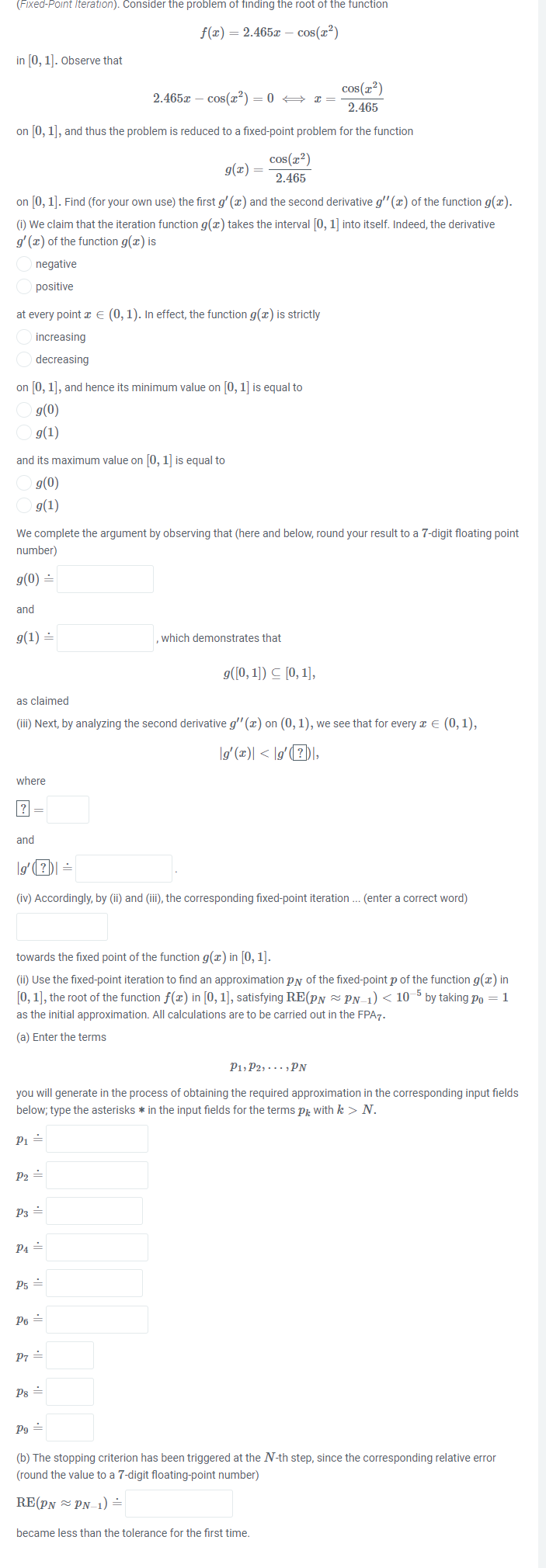Answered step by step
Verified Expert Solution
Question
1 Approved Answer
(Fixed-Point Iteration). Consider the problem of finding the root of the function f(x) 2.465x cos(x2) in [0, 1]. Observe that cos(22) 2.465x cos(x2) =

(Fixed-Point Iteration). Consider the problem of finding the root of the function f(x) 2.465x cos(x2) in [0, 1]. Observe that cos(22) 2.465x cos(x2) = 0 x= 2.465 on [0, 1], and thus the problem is reduced to a fixed-point problem for the function g(x) cos(x) 2.465 on [0, 1]. Find (for your own use) the first g'(x) and the second derivative g" (a) of the function g(x). (i) We claim that the iteration function g(x) takes the interval [0,1] into itself. Indeed, the derivative g'(x) of the function g(x) is negative positive at every point x = (0, 1). In effect, the function g(x) is strictly increasing decreasing on [0, 1], and hence its minimum value on [0, 1] is equal to 9(0) g(1) and its maximum value on [0, 1] is equal to 9(0) g(1) We complete the argument by observing that (here and below, round your result to a 7-digit floating point number) 9(0) = and 9(1) as claimed , which demonstrates that 9(0,1]) [0, 1], (iii) Next, by analyzing the second derivative g'(x) on (0, 1), we see that for every x = (0,1), (a)(7), where ? and g'(?) (iv) Accordingly, by (ii) and (iii), the corresponding fixed-point iteration... (enter a correct word) towards the fixed point of the function g(x) in [0, 1]. = 1 (ii) Use the fixed-point iteration to find an approximation PN of the fixed-point p of the function g(x) in [0,1], the root of the function f(x) in [0, 1], satisfying RE(PN PN-1) < 10-5 by taking po as the initial approximation. All calculations are to be carried out in the FPA7. (a) Enter the terms P1, P2, PN you will generate in the process of obtaining the required approximation in the corresponding input fields below; type the asterisks * in the input fields for the terms pk with k > N. P = P2 P3 P4= P5 = P6 P7 = P8 P9 = (b) The stopping criterion has been triggered at the N-th step, since the corresponding relative error (round the value to a 7-digit floating-point number) RE(PNPN-1) = became less than the tolerance for the first time.
Step by Step Solution
There are 3 Steps involved in it
Step: 1

Get Instant Access to Expert-Tailored Solutions
See step-by-step solutions with expert insights and AI powered tools for academic success
Step: 2

Step: 3

Ace Your Homework with AI
Get the answers you need in no time with our AI-driven, step-by-step assistance
Get Started


